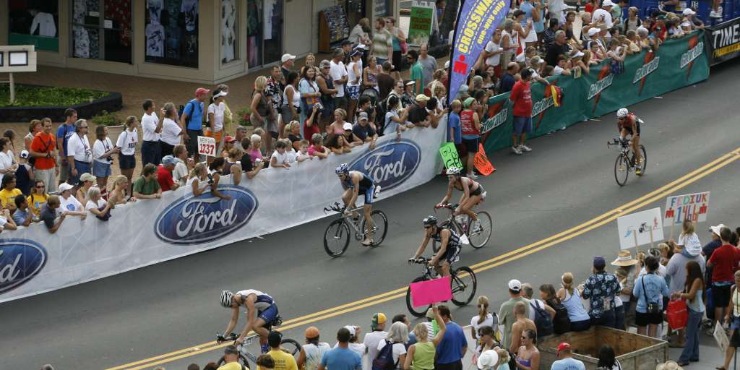A Spectator's Guide to IRONMAN
October 13th 2007

There are nine thousand books and ten times that many magazine articles telling you how to train for the Ironman. Remarkably, there is nothing anywhere telling you how to watch the Ironman. What makes this so weird is that there are vastly greater numbers of people who watch the race than actually do it. Now, doesn't it strike you as odd that no one has as yet seen fit to address the needs of this neglected yet vital component of the Ironman ohana?
Instead, tri magazine editors sit on the sidelines as tens of thousands of these poor bedraggled souls drift in and out of race venues the world over. The marketing possibilities alone are virtually limitless: Selling one or two chain polymerized, ergonomically designed, form-fitting and aerodynamically optimized hi-performance hydration systems (referred to by insiders as "water bottles") for a hundred bucks to gullible IM newbies is one thing. Selling their families dozens of double-death cheeseburgers, overpriced genuine Kailua-Kona margaritas and custom-screened "Your-Athlete's-Name-Here Fan Club" t-shirts is potentially far more rewarding. (You can trust my business acumen, even if I did buy Enron at $130.)
But as magazine editors know all too well, you can't sell the ad space unless you have the readers, and to get the readers you have to scatter some actual content among the ads for shoelaces that promise to put you on the podium.
Given that The Big One is only a day away (I'm referring to the Ford Ironman World Championship, not a repeat of last year's 6.7 lava rocker), I'm going to kick things off by addressing myself to those unsung heroes who make the trek to Kona even though they get neither the glory or the ink.
Loved ones, herewith a few tips to make your race day all you hoped it would be.
· Don't forget to train: It isn't easy being an Iron spectator. Believe me, I've done it twenty times and can tell you that, if you go into it cold, you're going to suffer. Your SPAM (significant participating athlete mate) is counting on you to smile and shout encouragement no matter how you're feeling, and let's be honest here: How you feel counts about as much on the Big Day as it did during ten months of training for the Big Day. So don't neglect your own training.
Your basic endurance-watching training should consist of slathering SPF 900 all over yourself and then sitting two feet from the business end of a flamethrower set to max power while staring forlornly into the distance as though waiting for something to happen. Remember how you used to sit by the fireplace for twelve hours waiting for Santa? It's a lot like that, except without the leftover eggnog you used to sneak to take the edge off. About every three hours, pick yourself up, walk around aimlessly for five or six miles, then sit back down in front of the flamethrower. Repeat endlessly, or until you lose count, whichever comes first.
· Don't peak too early: This is a common mistake among amateur watchers. Another is to forget that spectating isn't just about watching the race; it's about being in Kona for a week or two beforehand. So you want to be sure that you work your way up to thirty-six holes a day slowly, rather than all at once.
Thirty-six holes a day isn't just important; it's critical. Veterans can tell you that the last thing you want to be anywhere near while supporting your SPAM in Kona is your SPAM while he's in Kona. SPAMs in Kona are like badly constipated wild boars, which is to say, a little touchy, to the extent of being perfectly willing to rip your liver out through your navel if you look at them the wrong way. The Big Island being the single most isolated land mass on earth, there aren't that many places to hide. The Mountain Course at the Kona Country Club is one, and there are others.
· Make checklists: Triathlon-watching is too complicated to be left to the vagaries of memory. Rather than agonize over whether you've remembered everything and risk starting off your Hawaiian odyssey by fighting two thousand cruise ship passengers for the express lane at Wal-Mart, take a tip from airline pilots and make a checklist. Some items on my own list include a DVD player, a portable practice putting green, a towel (for when the race course gets close to the beach), a beach chair and matching umbrella, a cooler full of brewskies and pork rinds and a good assortment of fine stogies, including some extras to hand out to natives, who have been known to let spectators slip into the lanai for a quick nap or a half hour of Dr. Phil in exchange for a primo Cohiba.
· Sex the week before Ironman: [this space intentionally left blank]
· Negotiating the course:The swim is fairly self-explanatory. The only tricky part is anticipating your SPAM's likely split. It's a good idea to give yourself a couple of minutes leeway in case she catches a good draft or dislocates a shoulder or has her jaw broken. Let's assume your best guess is 1:10 and you're staying at the Royal Kona. Since the gun won't go off any earlier than 6:55 am, make sure you don't sleep past 7:20 so you can get a nice shot of the swimmers stroking past the third buoy before you hit the rack again.
· Understand the local lingo: I'm not talking about the Hawaiian language. You can forget that. You'll hear a lot about how beautiful and musical and poetic and culturally vital Hawaiian is. What you'll never hear is anybody actually speaking Hawaiian. Nobody knows how, except one guy, and he doesn't have anybody to talk to.
What I'm talking about is people blithely referring to places that don't exist. An example is the stretch of Palani between Kuakini Highway and the Queen K called "Pay 'n' Save Hill." There is no Pay 'n' Save there. There is no Pay 'n' Save within 2,800 miles of Pay 'n' Save Hill. There is a Sack 'n' Save across the street, and a Sizzler, but no Pay 'n' Save. Up until six years ago there was a Payless, and then there was a Ross store and now there's something else. But tenyears ago there was a Pay 'n' Save on the spot, and it's still called that because "Ross Stores Hill" doesn't cut it and "Piss 'n' Moan Hill" is reserved for use by actual Ironman participants.
Knowing stuff like this separates the virgin watchers from the veterans. This is why "doing the Hilton" during swim training has been known to result in exhausted athletes being picked up somewhere in the vicinity of the Solomon Islands still stroking valiantly while waiting for the Hilton to show up because it's been the Royal Kona since 1986.
· Don't eat anything on race day that you didn't eat while training. This is age-old triathlon wisdom...or at least as age old as you can get in a sport that started after Nixon left office. It's doubly important for spectators, whose constitutions are usually screwed up even on a good day and for whom there are no sponsors plying them with products they've been using all year long anyway. In an exotic environment like Hawai'i where there are all kinds of strange and potentially lethal microorganisms, stick with packaged brands you trust, like Hostess, Entenmann's and Hershey.
· Race course motivation: Remember that you're there to help your SPAM. If you know that her nearest competitor is eight miles behind, don't hesitate to say, "You better step on it babe: she's right on your tail!" as a means of inducing higher performance. However, after you confess your little motivational cleverness while she's on her way into the medical tent, you are best advised to do so quickly and then step smartly away from the blast zone.
· Take the time to learn new things. Seek out expo vendors and learn how you can cauterize lactic acid, incarcerate free radicals, hydrosynclasticize oxygenated gluconodules and boost your nitrous infidibulum levels…all from products whose first four listed ingredients are water, fructose, red dye #2 and caffeine.
There's lots more I can tell you, but since another cardinal rule of Ironman-spectating is to pace yourself, I'll leave it for another time. Just remember to be disciplined: Plan the work and work the plan!
Good luck and see you at the finish. (That would be the bar at Pancho and Lefty's, where you might as well hang out while your SPAM is mainlining liter-bags of lactate because spectators aren't allowed in the medical tent.)
[Editor's note: Portions of this guide appeared in Competitor magazine a long time ago, back when there was a Pay 'N' Save on Pay 'N' Save Hill.]
